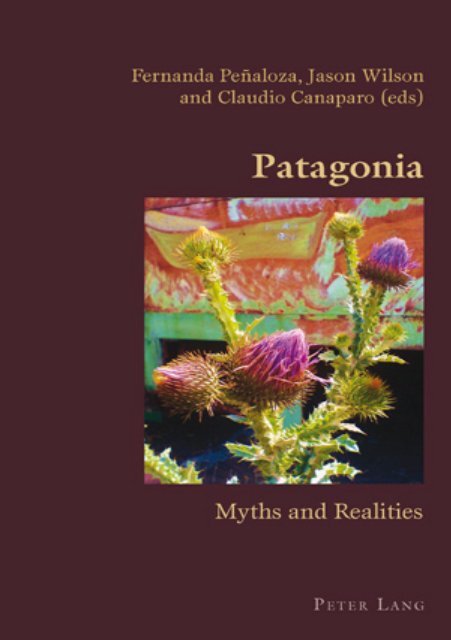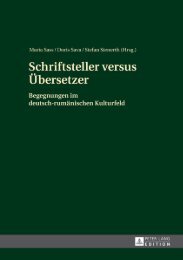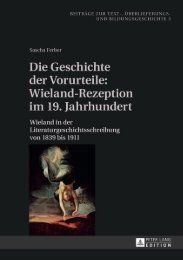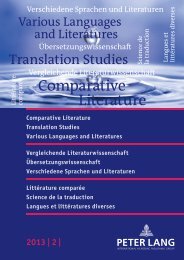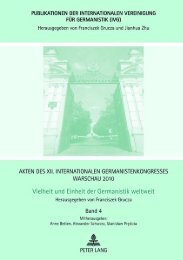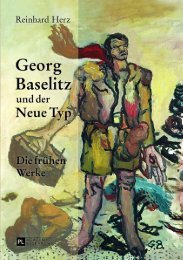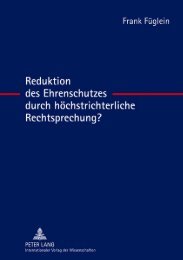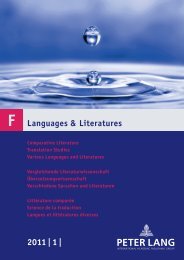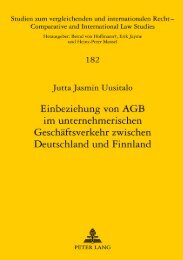Extract (PDF) - Peter Lang
Extract (PDF) - Peter Lang
Extract (PDF) - Peter Lang
You also want an ePaper? Increase the reach of your titles
YUMPU automatically turns print PDFs into web optimized ePapers that Google loves.
Fernanda Peñaloza<br />
Introduction:<br />
Myths and Realities: Mapping Scientific, Religious,<br />
Aesthetic and Patriotic Quests in Patagonia1<br />
Enacting nacting old myths of a timeless and dehumanised landscape, Bruce Chatwin<br />
and Paul Theroux, who unsurprisingly defined themselves as “literary<br />
travellers” (1), speculated about the connections between Patagonia and<br />
a remarkable group of canonical writers.2 Through the pages of Patagonia<br />
Revisited we are invited to trace the influence of “Patagonian” tales of brave<br />
seas, and monstrous creatures in Shakespeare’s The Tempest, Coleridge’s<br />
Ancient Mariner, Herman Melville’s Moby Dick, and Conan Doyle’s Lost<br />
World, among others. But the intertextual quest does not end there. Both<br />
1 Sections of this introduction as well as some of the ideas forming part of my paper<br />
on Thomas Bridges were included in my PhD thesis (Peñaloza, 2004) and have<br />
subsequently undergone substantial revision.<br />
2 For the circumstances of Chatwin’s trip to Patagonia see Nicholas Shakespeare, 287–<br />
303. Shakespeare’s account suggests that Chatwin’s knowledge of the Spanish language<br />
was very limited (289). This might explain the portrayal of Patagonia as a land of<br />
foreigners and exiles. From In Patagonia it is possible to infer that Chatwin conducted<br />
interviews mainly with people who spoke English. But also, when Chatwin writes<br />
about people who could well be either Patagonians by birth, Chileans or Argentines<br />
from other regions of those countries, he does not seem to hold conversations with<br />
them and sometimes uses terms like “Latins” or “Indian half-breeds” to refer to the<br />
locals. In relation to the indigenous peoples, he generally fixes them in the past as<br />
massacred populations and therefore extinct. Most recent analysis of Chatwin’s work<br />
on Patagonia include David Taylor, “Bruce Chatwin: Connoisseur of Exile, Exile as<br />
Connoisseur”, in Steve Clark, ed., Travel Writing and Empire: Postcolonial Theory<br />
in Transit. London: Zed Books, 1999. 195–211; and Claire Lindsay, “Luis Sepúlveda,<br />
Bruce Chatwin and the Global Travel Writing Circuit”, Comparative Literature<br />
Studies 43.1–2 (2006): 57–78.
2 Fernanda Peñaloza<br />
authors, but particularly Chatwin in his acclaimed In Patagonia, also speculated<br />
about the origin of the word that gave name to the region (Chatwin<br />
92–94; Chatwin and Theroux 36–39). The writers refer at length to the<br />
controversial issue of the word “Patagonia”. For many years it was thought<br />
that Patagonia came from the Spanish pata, which literally means paw, but<br />
can be used colloquially as the equivalent of foot.<br />
The supposition behind this interpretation is that when Magellan saw<br />
the Tehuelches, he was amazed by the size of their feet, and called them<br />
“Big-Foot”, that is “Patagón”.3 According to María Rosa Lida de Malkiel,<br />
the name did not come from the big footprints of the Tehuelches but<br />
from the pages of Primaleon of Greece, which is the English title for the<br />
translated version of one of several sequels to the medieval sagas Amadís of<br />
Gaul (321–323). Since the book was published in Spain seven years before<br />
Magellan’s trip, it is very likely that the Portuguese explorer read or knew<br />
about the terrifying beast called Patagón that appeared in it.4 The 1596<br />
English translation by Anthony Mundy, a supposed friend of Shakespeare’s,<br />
led to more speculation. According to this genealogy, the fact that The<br />
Tempest was published fifteen years after the English translation of Amadís<br />
indicates that Shakespeare found in the monster Patagón a model for Caliban.5<br />
Shakespeare also used two other texts to create Caliban’s evil deity:<br />
3 For a study of the myth of the giants from this perspective see Percy G. Adams.<br />
Travelers and Travel Liars 1660–1800. Berkeley: University of California Press, 1962.<br />
Chap. II.<br />
4 I have consulted the 1619 publication of Primaleon of Greece translated into English<br />
from French and Italian. In The Second Book, Primaleon, the hero of the saga, meets<br />
the Grand Patagón. Chapter XXXIII opens with a dialogue between Primaleon<br />
and Palantine that takes place while they are hunting: “I heare great marveiles of ye<br />
(Sir) answered Primaleon, truly I would gladly see a monster so admirable: never<br />
disire the fight of him, replied Palantine, for in sooth ye mere better see the Divell,<br />
than Patagón” (255). Even though the connection between Primaleón of Greece and<br />
Pigafetta’s chronicle might be difficult to prove, textualised Patagonia never seems<br />
to disappoint a reader willing to find analogies.<br />
5 Shakespeare drew heavily from tales of the “New World”, and in a two-way exchange<br />
of meanings, his Latin American readers borrowed heavily from his work as well.<br />
The most famous Latin American essay on aesthetic and philosophical sensibilities
Introduction 3<br />
Pigafetta’s account of Magellan’s circumnavigation of the world and Francis<br />
Fletcher’s journal of Francis Drake’s 1577–1580 voyages. In 1904, Walter<br />
Alexander Raleigh claimed that it was more likely that Shakespeare had<br />
found the name “Setebos” in Fletcher’s account (quoted in Mason Vaughan<br />
and Vaughan 40–41). In fact, Setebos is the name that Pigafetta gave to the<br />
god he thought was worshipped by the Tehuelches, and Fletcher simply<br />
reproduced it in his text.6<br />
Bruce Chatwin and Paul Theroux made of Patagonia the perfect setting<br />
for their post-modern textualised journeys. The authors engaged their<br />
travel experiences to Patagonia through other texts. All the way through<br />
their works, they make strategic use of literary invocations, expanding the<br />
visions of vastness which, in part, are echoing the images created in the<br />
nineteenth century by travellers who ventured to the region. In spite of<br />
the deep transformations Patagonia underwent from the “discovery” of<br />
the “Patagonian Giants” onwards, the landscape has somehow remained<br />
is “Ariel” by the Uruguayan José Enrique Rodó, published in 1900. Whereas the<br />
aerie spirit represents the truth and beauty of Latin America, Caliban embodies<br />
the utilitariansim of the US. However, it was Nicaraguan poet Rubén Darío who<br />
in 1895, with the publication of the newspaper article “El triunfo de Calibán”, first<br />
suggested the metaphorical use of Caliban to represent the US as he alluded to the<br />
Shakespearean character to criticise New York’s lack of spirituality. In his landmark<br />
essay, “Calibán: apuntes sobre la cultura de nuestra América” (1973) Cuban writer<br />
Roberto Fernández Retamar inverts the metaphorical use of the characters by suggesting<br />
that it is Caliban, not Ariel, who best represents Latin American identity.<br />
Whatever the irony contained in the fact that the very recognisable stereotype of<br />
the savage native which emerges in The Tempest is chosen to rebel against colonial<br />
rule, there is no doubt about the profound permeability of textual boundaries. Latin<br />
American writers were adding their voice to the pre-existing textual dialogue between<br />
Europe and the Americas, and their use of the Shakespearean characters shows that<br />
the trafficking of meanings from the metropolis to its periphery is a process that has<br />
appropriative power in multiple directions.<br />
6 More discussion on this issue is to be found in Marina Warner. “The Foul Witch<br />
and Her ‘freckled whelp’: Circean Mutations in the New World” (97–113); and<br />
John Gillies. “The Figure of the New World in The Tempest” (180–201), both in<br />
“The Tempest” and Its Travels. Ed. <strong>Peter</strong> Hulme and William H. Sherman. London:<br />
Reaktion Books, 2000.
4 Fernanda Peñaloza<br />
the epitome of nothingness, the land of exile, a ghostly scenario where the<br />
post-modern traveller can write: “nowhere is a place”.7<br />
The intertextual map outlined above links a wide mixture of narratives<br />
and their powerful symbolic investments that are therefore intertwined in<br />
an ambivalent and ambiguous process of creating, representing and confronting<br />
otherness. Such discursive intersections pertain to the western<br />
fascination with Patagonia, which can be dated to 1520, the year of Ferdinand<br />
Magellan’s circumnavigation. At the time the Portuguese explorer passed<br />
from the Atlantic to the Pacific through the strait that was named after him,<br />
it was believed that right at the very “end of the earth” there was a terrifying<br />
land, the legendary “Terra Incognita Australis”. In An tonio Pigafetta’s<br />
account of the Magellan expedition, the height of the first Tehuelche to<br />
meet Europeans is emphasised. With the language of amazement characteristic<br />
of the Early Modern period and marking the birth of one of the most<br />
enduring myths of the region, Pigafetta describes the Tehuelches as being<br />
of gigantic proportions. From then on, the southern region of Chile and<br />
Argentina has embodied powerful images that so easily appear to convey<br />
the monstrous, the uninviting, the alluring and the unexpected. Conquerors,<br />
explorers, adventurers, settlers, exiled, outlaws, scientists, missionaries<br />
and all kinds of real and imaginary visitors transformed this vast area of<br />
over 1 million square kilometres into an enigmatic territory.8<br />
7 Bruce Chatwin and Paul Theroux. Patagonia Revisited. Salisbury: Michael Russell,<br />
1985. 13. A long-running scientific enquiry around the rumours of giants in Patagonia<br />
discredited the tales of the explorers, but only to some extent. The strong belief that<br />
supported the myth for many years was the fifteenth century theory affirming that<br />
the closer to the North or the South Poles, the bigger the size of the people who live<br />
there. With the Enlightenment many journals fed the myth, but several scientists<br />
began to regard the issue with scepticism. Among them was the French natural<br />
philosopher, Georges-Louis Leclerc, Comte de Buffon (1707–1788) who denied<br />
the existence of giants by “proving” that animals and plants of the New World were<br />
small and degenerate in comparison to European.<br />
8 Whereas Chilean Patagonia extends from part of Los Lagos and the whole of Aysén<br />
and Magallanes known as the X, XI and XII regions, respectively, Argentine Patagonia<br />
is comprised by five provinces: Río Negro, Neuquén, Chubut, Santa Cruz and Tierra<br />
del Fuego. Argentine Patagonia was centrally controlled by the national government
Introduction 5<br />
The land of gigantic inhabitants created by Pigafetta’s description of the<br />
Tehuelches circulated widely among his contemporaries, and his became the<br />
narrative to be authenticated or discredited by later explorers. Furthermore,<br />
the claim that there were giants in Patagonia gained widespread acceptance<br />
over the centuries, bolstered by both travel writing and fictional narratives.<br />
One early European visual representation of the Tehuelches is to be found<br />
in Americae sive quartae orbis partis nova et exactissima descriptio, one of<br />
the most detailed ornate maps of the American Continent of the sixteenth<br />
century. Printed in 1562, over forty years after Magellan’s circumnavigation,<br />
the map was designed by Diego Gutiérrez, an official cosmographer and<br />
cartographer of the Spanish Government, and Hieronymus Cock, a noted<br />
Flemish engraver of the period. Among images of ferocious sea creatures,<br />
exotic animals and monsters, the map depicts two giants with their arcs<br />
and arrows standing in Tierra de Patagones. One of them is handing an<br />
arc to a Conquistador, whose head hardly reaches the waist of the giants.<br />
Just below the illustration and reinforcing the effect of the images, a Latin<br />
inscription reads “Gigantum Regeo”. Ten years later, after the publication<br />
of Americae in 1672, Luis Vaz de Camoens in his epic poem “The Lusiads”<br />
accuses Magellan of disloyalty for making his voyage under the auspices<br />
of the Spanish crown, but also acknowledges his achievements in a prophetic<br />
style:<br />
Rather more than half-way from Equator to the South Pole he will come on a land,<br />
Patagonia, where the inhabitants are of almost gigantic stature; then, farther on,<br />
he will discover the strait that now bears his name, which leads to another sea and<br />
another land, that Terra Incognita. (246)<br />
Pigafetta’s account shaped the imaginative universe of explorers willing<br />
to find giants in the South Seas. References to the Tehuelches’ supposed ly<br />
enormous size are not only to be found among early accounts and contemporary<br />
representations. After Magellan’s exploration, the Spanish and<br />
from 1884 when it was declared national territory divided in different sub areas<br />
which are now known as provinces. By 1955 all the national territories were declared<br />
provinces and therefore became less dependant of central control, except for Tierra<br />
del Fuego, which became a province as late as 1991.
6 Fernanda Peñaloza<br />
the English made a few attempts to colonise Patagonia, but the region<br />
remained virtually devoid of European settlements for over 300 years. The<br />
most important explorations to Patagonia in the sixteenth century were<br />
those of Pedro Sarmiento de Gamboa (1578) and Sir Francis Drake (1578).9<br />
From then on, interest in travelling around the region seems to have faded<br />
away until John Byron circumnavigated the globe once again (1740).10 Lord<br />
Byron is the main protagonist of <strong>Peter</strong> Hulme’s essay, which is the first one<br />
of this volume. Hulme focuses on Commodore Anson’s voyage round the<br />
world and the hardships the men on the Wager had to endure when the<br />
ship was wrecked off the eastern coast of Patagonia in May 1741. By historicising<br />
the meanings attached to two specific geographical spaces – islands<br />
and beaches – Hulme raises important questions about the dynamics of<br />
colonial power. Hulme’s reading of Byron’s self-representation as a man in<br />
a desperate situation shows that the discursive practices that emerged from<br />
this particular colonial encounter cannot be reduced to an account of a<br />
binary opposition between the colonising subject and the colonised other.<br />
A few decades after the shipwreck of the Wager, the Jesuit Thomas<br />
Falkner (1774) explored the area while living for thirty years as a missionary<br />
in Argentina, and James Cook surveyed the Patagonian coastline (1775).11<br />
The interest in rare accounts of Patagonia appeared to have gone astray,<br />
until the nineteenth century when explorers, missionaries and adventurers<br />
9 Edward J. Goodman’s historical account of early explorers in Patagonia is still the most<br />
authoritative; see The Explorers of South America, New York: Macmillan, 1972.<br />
10 Byron reported in his own account that the Tehuelches “were all cloathed in Skins of<br />
wild Beasts of different kinds which they wore as Highlander wears his Plaid, many<br />
of these Skins were very curious & very large, as indeed they ought to be to cover<br />
these People who in size come the nearest to Giants” (57). In one of the versions<br />
of Byron’s journal, there is an illustration that shows an English sailor, who like<br />
Pigafetta’s account and the Conquistador of Gutiérrez’s map, can only reach the waist<br />
of a Patagonian woman holding a child and her husband standing beside her. There<br />
is controversy around the authorship of the journal of Byron’s circumnavigation as<br />
many versions of the journal were almost simultaneously published.<br />
11 According to Bruce Chatwin and Paul Theroux, Falkner’s book was in the library<br />
of the Beagle (34). For the most recent analysis of Thomas Falkner’s text see Ernesto<br />
Livon-Grosman (51–70).
Introduction 7<br />
began to cast their eyes over to Patagonia again. As Ernesto Livon-Grosman<br />
observed, the gigantism of the Tehuelches was transferred to a landscape<br />
that was seen as equally seductive, due to its exoticism, and disturbing,<br />
for its vastness seemed to elude geographical surveys and white settlement<br />
(49). Indeed, although it may be that nineteenth-century travellers<br />
to Patagonia were less willing than their predecessors to find giants in the<br />
South Seas, the myth of gigantism did not completely evaporate; narratives<br />
about Patagonia combined the residue of such fantastic stories with<br />
scientific inquisitiveness, ethnographic curiosity, speculative commercial<br />
profits, missionary visions and aesthetic quests.<br />
Alcide D’Orbigny’s Voyage dans l’Amerique Meridionale. 1826–1833<br />
(1835), Charles Darwin’s entries on Patagonia in The Voyage of H.M.S.<br />
Beagle (1839) and George Chaworth Muster’s At Home with the Patagonians<br />
(1871) are without doubt the most influential texts of the period.12<br />
However, the list of travelogues, diaries and chronicles is significantly more<br />
extensive; it suffices to mention just a few: Benjamin Franklin Bourne’s<br />
The Giants of Patagonia: Captain Bourne’s Account of his Captivity Amongst<br />
the Extra ordinary Savages of Patagonia (1853); William Parker Snow’s A<br />
two years’ cruise off Tierra del Fuego the Falkland Islands, Patagonia, and in<br />
the river Plate (1857); Julius Beerbohm’s Wanderings in Patagonia.(1879);<br />
Lady Florence Dixie’s Across Patagonia (1880); and Titus Coan’s Adventures<br />
in Patagonia: a Missionary’s Exploring Trip (1880).13 Explorations of<br />
12 British explorations in the area were mostly linked with trade, missionary expeditions,<br />
and the establishment of sheep farming companies. In the case of Argentina, these<br />
colonial relations included the establishment of a colony formed by Welsh settlers<br />
(1865) and the sovereignty conflict for the Falkland Islands (Islas Malvinas). The<br />
Beagle’s enterprise took place in the early stages of this commercial British expansion.<br />
As Janet Browne states, the Beagle was issued a specific set of instructions from<br />
the British Government: “to ascertain the commercial and strategic potential of the<br />
east coast of South America” and “to reclaim the Falkland Islands from Argentina,<br />
literally showing the British flag” (464–465).<br />
13 Across Patagonia, written by Dixie in 1880, is the only published, book-length account<br />
of a British woman’s journey to Patagonia from this period. There is only one other<br />
female-authored travelogue to Patagonia that I have come across so far, the one written<br />
by the Welsh descendent Eluned Morgan. Her book is based on her 1899 trip from
8 Fernanda Peñaloza<br />
this period are the focus of Patience A. Schell’s essay, which analyses the<br />
relationship between Robert FitzRoy and Charles Darwin, by looking<br />
at how perceptions of place are mediated by notions of masculinity and<br />
friendship.14 Schell examines the Beagle’s enterprise by identifying the role<br />
homosocial friendship played in FitzRoy’s and Darwin’s experience of travel<br />
and exploration. Nineteenth-century representations of Patagonia are also<br />
examined by Fiona J. Mackintosh, who problematises notions of genre and<br />
gender by highlighting Lady Florence Dixie’s intricate engagement with<br />
imperialistic and masculine discourses. Mackintosh traces these configurations<br />
of gender, power and discourse in three texts written by Dixie: her<br />
travelogue on Patagonia and two books for children set in the region.<br />
At a rhetorical level, most of the nineteenth-century travel to Patagonia<br />
had much to do with hopes of discovery, satisfying the public’s curiosity<br />
for the then ‘unknown’ parts of the world with their accounts. Through<br />
powerful discursive operations, the natives encountered by the travellers<br />
became confirmation of western civilisation’s ancestry.15 In the attempt to<br />
the Atlantic Coast to the Andes. Her experience across the Patagonian province of<br />
Chubut was first published in Welsh and it was entitled Dringo’r Andes. Casnewyddar-Wysg:<br />
Southall & Co., 1907. Morgan’s account has been printed and translated into<br />
Spanish as Hacia los Andes. Trans. Irma Hughes de Jones. Rawson: El Regional, 1982.<br />
Eluned Morgan’s father was one of the first settlers to arrive in 1865 to the province<br />
of Chubut. She was born on board a Welsh ship while her parents were going back<br />
to Patagonia after staying for some time in England in 1870. For more details on<br />
Morgan’s life see Virgina Haurie, Mujeres en Tierra de Hombres. Historias reales de<br />
la Patagonia Invisible. Buenos Aires: Editorial Sudamericana, 1998. 883–884. Apart<br />
from Morgan’s journal, there are two female-authored articles about the region; these<br />
are “The Hassler Glacier in the Straits of Magellan,” Atlantic Monthly 30 (October<br />
1872): 72–478 and “In the Straits of Magellan,” Atlantic Monthly 31 ( January 1873):<br />
89–95. Both were written by Elizabeth Cary Agassiz, who was born in Boston in<br />
1822. She wrote those articles while accompying her husband, the Swiss naturalist<br />
Louis Agassiz, on scientific expeditions.<br />
14 This is one of the most tense and significant relationships of British history; therefore,<br />
it is not surprising that a recent novel has this subject as central to its plot. See<br />
Harry Thompson, This Thing of Darkness. London: Headline Review, 2005.<br />
15 By the time European travellers were undertaking their journeys, and the Chilean<br />
and Argentine colonising projects were being carried out, there were different<br />
groups of indigenous peoples in the Patagonian region. There are many conflicting
Introduction 9<br />
trace the prehistory of European culture, travel writers created crystallised<br />
moments of savagery that were to take the shape of pre-professional ethnographic<br />
accounts. Hence, the savage, a projection of the nineteenth-century<br />
fascination for mapping the origins of mankind, became the essential figure<br />
for the creation of a prehistoric record. In this sense, the “other” was always<br />
to be encountered as necessarily incomplete, as a fragment of history. By<br />
turning the journey into an ethnographic venture, reality remained distant,<br />
external and successfully objectified. The illusion this type of narrative<br />
conveys is that the traveller and her or his scrutinised object are immune to<br />
the transformations that every encounter presupposes. The ethnographic<br />
venture is the focus of Fernanda Peñaloza’s contribution to this volume, in<br />
which she analyses the two-fold paradoxical project of cultural preservation<br />
and transformation by examining the Anglican missionary enterprise<br />
of Thomas Bridges. Peñaloza’s main argument is that Bridges’s contradictory<br />
engagement with a culture he simultaneously wants to preserve and<br />
transform results in a representation in which, by its elusive presence, the<br />
“original” reveals with devastating force what Michael Cronin has called<br />
“the irreducible otherness of the foreign language and culture” (42).16<br />
interpretations of ethnic classification of native inhabitants of Patagonia. Such controversy<br />
arises from the fact that these forms of classification were devised by ex plorers,<br />
scientists and missionaries from the seventeenth century up to well into the twentieth;<br />
hence, some of those terms have been discarded by either anthro pologists<br />
who consider them inaccurate, or by the indigenous communities themselves who<br />
consider them offensive. The following is a simple sketch of how the indigenous<br />
population is frequently labelled and geographically located by anthropologists and<br />
ethno-historians: in the northwest of Patagonia, the Mapuche; in the area between<br />
the Limay River (North Patagonia), and the Santa Cruz River (South Patagonia), the<br />
Northern Tehuelche; in Tierra del Fuego, the Southern Tehuelche or Aóni-kénk; in<br />
the centre, the Selk’nam; in the extreme east of Tierra del Fuego, the Yaghan and the<br />
Alakaluf or Kaweskar. For a discussion on the subject from an anthropological and<br />
archaeological perspective, see the already mentioned work of Briones and Lanata.<br />
16 Most conventional portrayals on the indigenous peoples of the region are – quite<br />
predictably – constructed around cultural encounters in which the “other” is an undifferientiated<br />
collective ethnic group, to which the generic term “Indian” is applied.<br />
Indeed, most of the texts analysed in this volume deploy an individuated “civilised”<br />
subject encountering a depersonalised “primitive”, often resulting in stereotyped
10 Fernanda Peñaloza<br />
But of course, it was not only nineteenth-century anthropological<br />
curiosity that became integral in shaping images of Patagonia, so too, were<br />
aesthetic frames. Indeed, in the travel-writing tradition the language of<br />
aesthetic landscape transformed the Patagonian geography into a sublime<br />
experience in which the evocation of an overpowering nature obscures the<br />
historical and cultural grounds of the appropriative power of colonial discourse<br />
and colonial enterprises. W. H. Hudson in Idle Days in Patagonia<br />
synthesises the overpowering effects of the Patagonian landscape:<br />
Judging from my own case, I believe that we have here the secret of the persistence<br />
of Patagonian images, and their frequent recurrence in the minds of many who have<br />
visited that gray, monotonous, and in one sense, eminently uninteresting region. It is<br />
not the effect of the unknown, it is not imagination; it is that nature in these desolate<br />
scenes moves us more deeply than in others. (193)<br />
Even though, as Joy Logan has observed, Patagonia “is a land locked<br />
into the fiction of its existence” (67) both the real and imaginary possession<br />
representations. The generic term “Patagonian Indian” – as well as the many labellings<br />
and categorisations created around it, including those that aimed at being accurate<br />
and descriptive – arose in specific historical contexts and asumed a broad range of<br />
forms with concomitant political and cultural implications. Although contributors<br />
to this volume do not necessarily have in common similar theoretical and ideolgical<br />
views, what authors do share is an awareness of the implications of this need for classification<br />
of the indigenous population of Patagonia. Hence, even when the authors<br />
are not explicitly clarifying their position regarding this question, the reader should<br />
interpret that when the term “Indian” is being used, this choice does not respond<br />
to the attempt to describe indigenous peoples, but rather to contribute to a critical<br />
awareness of the creation and trajectory of images and ideas on Patagonia. In fact,<br />
when the authors reproduce the term “Indian” as it appears in some descriptions,<br />
they are exposing how, when and by whom such terminology is being used, as in<br />
many cases, it is virtually impossible to clarify to which specific indigenous group<br />
the term is being applied. Therefore, the indigenous peoples of Patagonia, who were<br />
scrutinised and written about in many works analysed here, are discussed in this<br />
volume in terms of their represenation, not because we are unaware of the heterogeneity,<br />
mobility and variety of indigenous identities, but rather because this is our<br />
workable approach to the study of the representations of indigenous peoples in the<br />
region.
Introduction 11<br />
of Patagonia are vital for understanding the colonising vision that underlies<br />
the discursive ramifications of the fascination for the region, which,<br />
in many ways, has been instrumental in the political and economic expansion<br />
plans of the Chilean and Argentine governments in their respective<br />
nation-building processes. Tales of vastness, emptiness and savagery<br />
fitted quite comfortably with the ideological framework that gave shape<br />
to the territorial expansion plans conceived by the elite Creoles of Buenos<br />
Aires and Santiago. In other words, the images that emanate from these<br />
narra tives decisively contributed to an intricate ensemble of cultural relations<br />
and national concerns already at play in hegemonic discourses on<br />
national identity that justified the physical and cultural displacement of the<br />
in digenous populations in favour of European and Creole settlement.<br />
In the nineteenth century, a persistent feature of Argentina’s attempts<br />
to activate the economy was the conflict over land in the countryside, which<br />
included the expansion of the frontiers by means of defeating indigenous<br />
tribes. From 1853 onwards, different Argentine governments accomplished<br />
measures for attracting immigrants from various parts of the world with<br />
the aim of establishing white settlements in areas inhabited by indigenous<br />
tribes. One of the most remarkable of these ventures was undertaken with<br />
the support of a Welsh nationalist, Michael D. Jones, who became convinced<br />
that the “desolate” region of Patagonia could be the best place in<br />
which to preserve Welsh cultural heritage. Simultaneously, the establishment<br />
of a colony in Patagonia was part of the Buenos Aires government’s<br />
strategy in establishing its authority in the region. The first group of Welsh<br />
settlers, about 150 people, sailed from Liverpool to Patagonia aboard the<br />
Mimosa. On 28 July 1865 they landed in Bahía Nueva, the western extremity<br />
of Golfo Nuevo, later to be known as Puerto Madryn. Edwyn Roberts,<br />
Lewis Jones and Abraham Mathews were among the first Welsh to arrive<br />
in June 1865.17 Paul W. Birt deals with the Welsh enterprise by exploring<br />
the construction of a Welsh–Patagonian sense of identity through a reading<br />
of autobiographies. By analysing aspects of the work of several Welsh<br />
settlers and writers during the 1915–1935 period, Birt looks at how personal<br />
17 For a well-researched history of the establishment of the Welsh colony see Glyn<br />
Williams, The Desert and the Dream. Cardiff: University of Wales Press, 1975.
12 Fernanda Peñaloza<br />
and collective memories are intertwined with the founding myths of the<br />
colony, including the initial trek in 1865 from the Atlantic port of New Bay<br />
South to the river Chubut, the first contacts with the indigenous peoples<br />
and the murder of Aaron Jenkins in 1877.<br />
In spite of the successful establishment of the Welsh settlers, many<br />
areas of the now Argentine side of the region were still unoccupied by the<br />
Government and, consequently, the claims of Chilean authorities over<br />
Patagonian territory became a real threat. Indeed, during the second half<br />
of the nineteenth century, Patagonia became central to both Chilean and<br />
Argentine border claims. The political leaders of the newly formed republics<br />
showed their inability to cope with the conflicting problems of territorial<br />
demarcation that arose after the wars of independence from the Spanish<br />
crown. The immediate response to this new state of affairs was the application<br />
of the uti possidetis principle, which legally defined possession of<br />
each colonial jurisdiction previously under Spanish rule. Although the<br />
principle was perceived as a practical resolution to possible conflicts, in<br />
the southern area of Chile and Argentina the difficulty of implementing<br />
the uti possidetis principle soon became apparent: justifying that Patagonia<br />
was actually explored, occupied and settled during colonial times<br />
was not an easy task. Hence, the occupation of the areas inhabited almost<br />
exclusively over centuries by indigenous groups, who managed to secure<br />
their dominance in the area, became strategic to strengthening Chile’s and<br />
Argentina’s territorial ambitions. Although the Chilean constitution of<br />
1833 recognised as national boundaries Cape Horn on the south and the<br />
Andean cordillera on the east, to the south the Mapuche were virtually in<br />
possession of all the territory south of the Bio-Bio, successfully impeding<br />
the extension of the frontier. In spite of a long sequence of mutual hostility,<br />
aggression and bitterness the nineteenth century, heated discussions over<br />
Patagonian territory were resolved in amicable terms by the mediation of<br />
King Edward VII of England in 1902. As a result of the arbitration, Tierra<br />
del Fuego was divided between the two countries, and Chile was given the<br />
banks of the Straits of Magellan.<br />
According to Cameron G. Thies, the conflict was triggered by Chile’s<br />
fears of “British imposition on her sovereign claims to the area, as Britain<br />
had recently reasserted sovereignty over the Falkland Islands in 1833” (411).
Introduction 13<br />
In order to avoid this situation in what the Chileans considered their territory,<br />
“Chile sent an expedition to set up a military base known as Bulnes at<br />
Puerto del Hambre (Port Famine) on the Brunswick Peninsula on the Strait<br />
of Magellan by 1843, which was later moved to Punta Arenas on the eastern<br />
shore of the peninsula in 1849” (Thies 411). As Francisco M. Goyogana<br />
observes, the response of the Argentine authorities was rather slow as they<br />
addressed this issue four years later: in 1847 Juan Manuel de Rosas claimed<br />
in a speech to the legislative assembly that the territory occupied by Chile<br />
was in conflict with the sovereignty of the Confederation (Goyogana 33).<br />
Whereas foreign interests provoked the immediate reaction of Chile, the<br />
Argentine claim to the Patagonian region was prompted by the fear that<br />
the Chilean government would implement the ambition to expand its<br />
national territory across the Andes range. This period marks the launching<br />
of Argentine and Chilean explorations into the bordering territories.<br />
Both the enterprises of Guillermo Cox in Chile with his Viaje en las rejiones<br />
septentrionales de la Patagonia (1862–1863) and that of Francisco P. Moreno<br />
in Argentina, some years later with Viaje a la Patagonia Austral (1879), are<br />
illustrative of the territorial ambitions of both countries. Both governments<br />
hoped the surveying of the land under dispute would provide the necessary<br />
topographic knowledge upon which to base their territorial claims. The<br />
geographers, naturalists, anthropologists and adventurers who embarked<br />
on these territorial explorations played a key role in the incorporation of<br />
Patagonia into the Chilean and Argentine national territories.<br />
Also, it was of paramount importance to provide definite reports on<br />
the interior of the Patagonian region in order to evaluate the feasibility of<br />
establishing settlements. For instance, Cox writes in his travelogue that<br />
his exploration in the area responds “not only to scientific and commercial<br />
interests, but also to humanitarian benefits as it aims to facilitate the<br />
colonisation of these regions” (Cox 36). Thus, functional to nationalistic<br />
agendas and economic interests, Patagonia was conceived first by Chile and<br />
Argentina as a region suitable for sheep farming and later for oil exploration<br />
and mining. On both sides of the Andes, Patagonia’s natural charm<br />
and promise of profit remained linked with the idea of an empty space,<br />
whose sterility and isolation had only just been heroically confronted by<br />
intrepid travellers and brave pioneers. The indigenous peoples remained
14 Fernanda Peñaloza<br />
marginal to the history of the region, mentioned only as an ethnographic<br />
curi osity, romanticised or demonised but, either way, doomed to disappear.<br />
The official historical accounts of Patagonia privilege narratives in which<br />
the region is the epitome of emptiness, and its land’s lucrative potential is<br />
only partially and temporarily hindered by vanishing “Indians”, unfit to cope<br />
with the white creoles’ notions of progress. The suffering of the indigenous<br />
peoples, who were deliberately excluded or killed in the process, was to be<br />
seen as the inevitable consequence of civilisation.18<br />
The most dramatic example of such abuse of authority comes from<br />
Argentina with the territorial military usurpation led by Julio Argentino<br />
Roca in 1879. Known as the Campaña del Desierto (Campaign of<br />
the Desert), this military crusade killed at least 1,313 and captured over<br />
12,000 people, mostly of Mapuche origin, between April and July 1879.19<br />
The Argentine government used two strategies to guarantee control<br />
over the area: direct violence by killing, imprisoning and expelling from<br />
their territories large numbers of indigenous populations; and indirect<br />
violence by offering military rank and rations to “Indians” who showed signs of<br />
loyalty to the country.20 The Campaign of the Desert also aimed to survey<br />
the occupied territory and in this sense it is important to highlight that<br />
“the exploration of Patagonia and the indigenes’ territories preceded the<br />
real dominion of the Argentine state over the region” (Podgorny 161). This<br />
period of military advance is discussed by Jens Andermann, whose essay<br />
examines how notions of space are configured in the acts of mapping and<br />
conquering territory. By looking at the works of Estanislao Severo Zeballos<br />
18 There are many historical accounts that in one way or another subscribe to this view<br />
of Patagonia. See for example the works of Aquiles Ygoborne and Roberto Hosne.<br />
19 For detailed figures see Carlos Martínez Sarasola, Nuestros Paisanos los Indios. Vida,<br />
Historia y Destino de las Comunidades Indígenas en la Argentina. Buenos Aires:<br />
Emecé, 1993. 282.<br />
20 Treaties and agreements between governmental authorities and indigenous leaders<br />
known as caciques were frequent. For a recent analysis of the complex system of<br />
cacicazgos see Gladys A. Varela and Estela M. Cúneo, “Líderes indígenas y relaciones<br />
interétnicas en la Norpatagonia durante los siglos XVIII y XIX”, in Susana Bandieri,<br />
Graciela Blanco and Gladys Varela, eds, Hecho en Patagonia: La historia en perspectiva<br />
regional. Neuquén: Editorial de la Universidad Nacional del Comahue, 2005. 53–84.
Introduction 15<br />
and Carlos María Moyano, Andermann argues that in these military ventures,<br />
the production of cartography and expedition narratives entails<br />
complex discursive operations, which result in the construction of “blank<br />
spaces” and “self-effacing protagonists” that are functional to the Argentine<br />
project of territorial expansion.<br />
Contemporary to the cartographic and narrative representations mentioned<br />
above is the official report of the scientific commission that took<br />
part in the expedition to the Río Negro in the framework of the Campaign<br />
of the Desert, in which the ambitions of extermination of the indigenous<br />
populations are communicated with a tone of triumph: “In order to conquer<br />
those 15,000 leagues efficiently, it was necessary to cleanse them completely<br />
of Indians [...] The results show that it was feasible, and even easy to extirpate<br />
the Indians, down to the very last one, from the area that was the intended<br />
addition to the possessions of the Republic” (xi–xii). The report continues<br />
by stating that the main outcome of the campaign had been security and<br />
protection for a future phase of “civilisation and production” (xii). This<br />
triumphant victory over savagery achieved by “cleansing” the Patagonian<br />
territory is followed by a description of the fauna and flora of the region as<br />
recorded by the scientists who joined the campaign.21 The joint presence<br />
of the military and scientific discourses in this report shows the successful<br />
assimilation of positivism. The racist hierarchies that ensured the implementation<br />
of the civilisation/barbarism dichotomy were legitimised by<br />
the adoption of a rigid rational pattern inspired by European values. This<br />
traditional dichotomy, made prominent in Argentina with the publication<br />
of Sarmiento’s Facundo in 1845, remained a constant formula that not only<br />
provided the ideological framework justifying the Argentine government’s<br />
dominance over the Patagonian territory, but also made it possible to forge<br />
a model of national identity based on whiteness and European lineage.22<br />
21 The scientists were mostly academics who worked in partnership with the military<br />
authorities. Their mission was to create an extensive zoological, botanical and geological<br />
catalogue. Among them were Adolfo Doering, D. G. Lorentz, F. Schulz and<br />
Gustavo Niederlein (Podgorny, “La Patagonia como santuario”, 166–167).<br />
22 As Nancy Stepan has noticed, this model became more rigid in the twentieth century<br />
when Argentina became a paradigmatic case in Latin American debates on eugenics.
16 Fernanda Peñaloza<br />
The conflicts that arose from the colonising projects of Argentina and<br />
Chile over the Patagonian region demonstrate that although the ruling<br />
classes endorsed the European ideas of modernity and encouraged European<br />
investment and immigration, thereby affirming white supremacy,<br />
this process was not a simple practice of replication. The elite Creoles, in<br />
their struggle to build up a nation, envisaged a modernisation project that<br />
strategically combined local versions of European elements with a search<br />
for identity highly attached to a sense of authenticity that the landscape<br />
seemed to convey. Far from benefiting from the white Creole’s selective use<br />
of European creeds, the natives of Patagonia who survived wars of extermination,<br />
appropriation of their natural resources, expulsion from their<br />
territories, contagious diseases and forced labour had to develop complex<br />
strategies of resistance in order to reconstruct a collective historical memory,<br />
which was almost wiped out.<br />
Despite a long history of displacement, the indigenous peoples of<br />
Patagonia have maintained a dialogue with a fluid cultural network that<br />
has often negated their legitimate presence. One cannot miss the continuity<br />
of certain forms of historical amnesia, but neither can one ignore that the<br />
indigenous voice is dynamically circulating in the culture of the Patagonian<br />
region. One example of this lending and borrowing of meanings is a poem<br />
that won the highest prize in the Eisteddfod of the Chubut Valley in 1990.23<br />
From its title we learn that the poet pays tribute to the kultrún, a drum<br />
used in the ngillatún, an ancestral Mapuche ceremony. In the poem the<br />
kultrún is being displayed in a museum cabinet: “It is as if from the earth<br />
a piece of heart had been pulled up and still beating it had been put […]<br />
in the cabinet of things that had died.” In spite of apparently being lifeless<br />
According to Stepan, compared with other countries in the region, Argentina was<br />
“the most conventionally racist in its eugenic ideology. In 1918 the country considered<br />
itself to be largely white and immigrant; its black population, once quite sizeable,<br />
had by the 1880’s been reduced to less than two percent of the national population<br />
[…] Indeed, Argentina seemed to many Latin Americans to be the only country<br />
that had realised its elites’ old dream of racial transformation by whitening and<br />
Europeanisation” (139).<br />
23 By local poet Juan Carlos Coralini.
Introduction 17<br />
due to its forced confinement, the kultrún “is still out there – silence that<br />
beats – like something that has not yet died, in search of Nguenechén up in<br />
the mountain” (quoted in Virkel de Sandler and Gutiérrez de Jones 28).<br />
Here we have the Welsh tradition of the Eisteddfod interlaced<br />
with new interpretations of the indigenous culture’s resistance to being<br />
objectified and forgotten. The poem attempts to reconstruct an historical<br />
scene of appropriation and commodification, and to expose the failure to<br />
confine the Mapuche culture to permanent silence. Whereas the poem’s<br />
effect should be justly judged as limited because it obviously cannot undo<br />
the history of domination it is denouncing, its intention deserves to be<br />
viewed as transgressive in the sense that the very same history it cannot<br />
possibly change is being retold in a different way. These processes of cultural<br />
transformation need to be acknowledged and encouraged as they<br />
expose both the difficulties and the possibilities the indigenous peoples<br />
of Patagonia are facing in the wider context of Latin American debates<br />
on the question of resistance.<br />
Indeed, what the poem briefly discussed reflects is the process by which<br />
the indigenous identity, in this case the Mapuche, had to be renegotiated<br />
in terms of transculturation where the singularity of such identity, appropriated<br />
by the vanishing discourse, is therefore no longer valid.24 Clifford<br />
writes,<br />
Throughout the world indigenous populations have had to reckon with the forces<br />
of “progress” and “national” unification. The results have been both destructive and<br />
inventive. Many traditions, languages, cosmologies, and values are lost, some literally<br />
murdered; but much has simultaneously been invented and revived in complex,<br />
oppositional context. If the victims of progress and empire are weak, they are seldom<br />
passive. (The Predicament 16)<br />
24 Stuart Hall has suggested that even though there are no authentic roots to which<br />
cultures can return, there is a sense of origin which it will be wrong to see as a “mere<br />
phantasm” because the “past continues to speak to us”. However Hall continues: “it<br />
no longer addresses us as simple, factual ‘past’, since our relation to it, like the child’s<br />
relation to the mother, is always already ‘after the break’” (395). The positioning of<br />
the colonial subject in relation to the histories of contact that shaped it demands<br />
recognition of both what is no longer there and what has been created.
18 Fernanda Peñaloza<br />
One of the ways in which historicised notions of indigenous identities<br />
have been invigorated is through the development of the production<br />
of a vibrant Mapuche poetry, often published in both Mapudungun and<br />
Spanish, and whose most contemporary visible voices are Elicura Chihuailaf,<br />
Leonel Lienlaf, Jaime Luis Huenun, and Graciela Huinao.25 Since the aesthetic<br />
project of these poets is at times presented as a de nouncing voice of<br />
the history of colonisation of the Patagonian region, their works are vital to<br />
exploring the interrelations between the commodification of cultural difference<br />
and complex forms of cultural appropriation, negotiation and agency.<br />
This literary phenomenon, which is usually referred to as “ethnopoetry”, is<br />
far more established and recognised in Chile than in Argentina, with a very<br />
significant international projection through the Mapuche Diaspora.<br />
However, it is not of course only in the cultural domain where the<br />
indigenous peoples are developing dynamic and creative self-representational<br />
practices but also in the political arena with their struggle for their<br />
rights over land. The region is indeed witnessing the uprising of indigenous<br />
movements which are forcing recognition of their culture and their constitutional<br />
rights. In the last few decades, the Mapuche have been protagonists<br />
of violent confrontations with the police, the legal system and<br />
local and national governmental authorities. In Argentina and Chile the<br />
Mapuche strategy of occupying land owned by the government or private<br />
companies has often resulted in brutal evictions; and street demonstrations<br />
aimed at drawing attention to the territorial conflicts frequently end<br />
with the imprisonment of the indigenous movements’ leaders. Mapuche<br />
activists repeatedly denounce they are victims of all kinds of ill-treatment<br />
and abuse from local authorities and landowners alike; and, as a consequence,<br />
they resort to extreme protest tactics such as hunger strikes or<br />
25 Academic interest in Mapuche poetry is also well-established in Chile. See for example<br />
Sonia Montecino, “Literatura mapuche: Oralidad y escritura”, Simpson 7, Vol. II<br />
(1992): 155–166; Iván M. Carrasco, “Literatura etnocultural en Hispanoamérica:<br />
Concepto y precursores”, Revista Chilena de Literatura 42 (1993): 65–72; and Hugo<br />
Carrasco, “Poesía mapuche actual: De la apropiación hacia la innovación cultural”<br />
Revista Chilena de Literatura 43 (1993): 75–87.
Introduction 19<br />
they become political exiles.26 Like many indigenous groups across Latin<br />
America, different Mapuche organisations are developing a fluid information<br />
network that takes advantage of technological developments brought<br />
about by the use of the Internet and they are therefore generating a significant<br />
range of online publications as well as magazines, periodicals,<br />
newspapers, books, and pamphlets that are channelling the political and<br />
social concerns of the Mapuche population. It was precisely this dynamic<br />
network of information that attracted international attention to the most<br />
visible conflict related to land ownership, between a Mapuche family and<br />
the Benetton group. The multi-million investment the Italian designer<br />
Luciano Benetton, who according to Susana Mabel López owns 900,000<br />
hectares (130), made in the region is part of a wider phenomenon: the<br />
natural riches of Patagonia are attracting a significant number of wealthy<br />
entrepreneurs who are speculating with the region’s potential profits. This<br />
phenomenon started in the 1990s and seems to be developing steadily with<br />
uncertain outcomes in the near future.27<br />
The tragic irony is that the myth of the End of the Earth still prevails,<br />
attracting tourism with commercial benefits for the region, but at<br />
same time new forms of territorial expansion have emerged, thus bringing<br />
about unsolved problems of the past and causing even more dramatic<br />
consequences. Patagonia appears to convey the image of utter wilderness,<br />
an empty land of wonders awaiting rediscovery by tourists or preservation<br />
26 These forms of abuse of power are sadly reminiscent of the killing of strikers in<br />
Patagonia during the years of 1921–1922, which was a direct consequence of the<br />
development of latifundios and its system of exploitation. Osvaldo Bayer is the<br />
most authoritative historian on these events and published four volumes between<br />
1972 and 1975, which dwelt in detail on the violent repression excercised by the<br />
Argentine government against ther rural workers. A new edited version of his work<br />
is to be found in Osvaldo Bayer, La Patagonia Rebelde: Edición definitiva. Buenos<br />
Aires: Planeta, 2002. Bayer also wrote the script of Héctor Olivera’s 1974 film La<br />
Patagonia. Whereas the army claimed twenty-six sheep farmers were killed during<br />
the strikes, Bayer asserts there were around 1,500.<br />
27 For an analysis of the economic changes Argentine Patagonia underwent during<br />
the period, see Augstín Salvia, ed., La Patagonia de los noventa: sectores que ganan,<br />
sociedades que pierden. Buenos Aires: La Colmena, 1999.
20 Fernanda Peñaloza<br />
by ecologists. Not surprisingly, travel books on Patagonia nowadays are<br />
usually photographic, depicting Patagonia’s natural richness devoid of<br />
human presence.<br />
Hence, although Patagonia has been mapped, surveyed and explored<br />
for over 400 years, and the narratives that created its most perdurable myths<br />
are evidence of histories of contact, colonisation and displacement, the<br />
sparse population of the region allows contemporary visitors to recreate<br />
the sense of emptiness experienced by the early travellers. As some of the<br />
contributors show in this volume, in travel writing aesthetic and scientific<br />
discourses can be used to naturalise boundaries and margins under the<br />
guise of celebration, nostalgia or disturbing assumptions of otherness. In<br />
this sense, it seems clear to me that the experience of travelling to Patagonia<br />
and the illusion of reaching the authentic is not an exhausted project. In<br />
spite of the social and ethnic conflicts that are to be found across the area,<br />
there are still old metaphors in operation on the Patagonian topography<br />
that the nineteenth-century explorers contributed to creating. Not long<br />
ago, in a newspaper interview in Argentina, Jean Baudrillard spoke about<br />
the connection between the metaphor of the ultimate and exile:<br />
Behind the fantasy of Patagonia lies the myth of disappearance, of drowning in desolation,<br />
of the end of the world. Of course, this is just a metaphor. I can imagine that<br />
travelling to Patagonia is like reaching the limit of a concept, like getting to the end<br />
of things. I know Australia and North American desert, but I have the feeling that<br />
Patagonia is the most desolate of places […] a land of exile, a place of de-territoriality.<br />
(quoted in Hosne, Patagonia 247)<br />
Patagonia has itself become not only a destination for those seeking<br />
nature in a pristine state, but also a topography that emerges as an image<br />
constantly switching between orders of reality and fantasy. By projecting its<br />
collective anxieties and fascination with otherness upon the barren plains<br />
of Patagonia, a myriad of textual references created a “fictional” topography<br />
frequently nullifying and voiding “reality”. Also, the fascination, to which<br />
Baudrillard refers, shows how powerful textual webs constantly mediate<br />
cultural encounters. Indeed, myths of desolation, vastness and infinitude<br />
about Patagonia still circulate widely about Patagonia in Patagonia and<br />
elsewhere.
Introduction 21<br />
Jason Wilson’s essay explores the power of these representations by<br />
examining the image of a desolate Patagonia as it emerges in the writings of<br />
Charles Darwin, W. H. Hudson, Francisco P. Moreno and Gordon Meyer.<br />
Wilson’s main argument is that the challenge this group of visitors faces<br />
is making sense of the fear the Patagonian silence seems to awake in them.<br />
According to Wilson, at the centre of these travellers’ reflections on their<br />
experiences is the profound sense of alienation they feel as the overwhelming<br />
emptiness of the Patagonian landscape seems to elude categorisation.<br />
Karl Posso also discusses the myth of the virgin territory by exposing<br />
how the imperialist gaze and nostalgia explicitly come together in Bruce<br />
Chatwin’s In Patagonia. By comparing Chatwin’s book with Evelyn Waugh’s<br />
Ninety-Two Days, Posso argues that regions such as Patagonia and the<br />
Amazon have been particularly alluring for twentieth-century English travel<br />
writers because their perceived remoteness and wilderness are functional to<br />
the imperialist fantasy of penetrating uncharted and unchartable territories.<br />
However, though fantasies of desolation and emptiness are still being<br />
projected onto the region, there are intricate and contestatory relations<br />
between representation and landscape. As already mentioned earlier, groups<br />
of indigenous people, who are fighting for their territorial rights over land<br />
now in possession of the state or private owners, are powerfully deconstructing<br />
such meanings. For instance, in a letter to the Argentine state,<br />
the Organización de Comunidades Mapuche-Tehuelche 11 de Octubre<br />
(Mapuche-Tehuelche Community’s Organisation 11 October) urges the<br />
Argentines to acknowledge their right to the recognition of their identity:<br />
“As you can see we are still alive; as long as there will be mountains, lakes,<br />
trees, volcanoes, rain, snow, there will be Mapuche-Tehuelche prepared to<br />
protect and take care of our Mapuchemapu (territory)” (1). The project of<br />
recovering and of reterritorialisation undertaken by the indigenous groups<br />
is a claim based on the very same landscape from which the texts that constitute<br />
the writing tradition about Patagonia discursively remove them.<br />
This example shows how the trope of the “vanishing Indian” is being<br />
powerfully challenged by politically committed voices. In turn, these dis- dis-<br />
cursive strategies pertain to a larger counter-narrative, which has paved the<br />
way for a relocation of alternative readings that can now expose the “certainties”<br />
of narratives of appropriation these strategies of resistance are already
22 Fernanda Peñaloza<br />
unsettling. From my point of view, this is what Edward Said has called “the<br />
new global consciousness” which “connects all the various local arenas of<br />
anti-imperial contest” (62). Indeed, much of the developments in the vein<br />
of critique that has informed this editorial project are indebted to the fluid<br />
and subversive dynamics of resistance of such “arenas”. In this sense, the<br />
ethno-historical work of Walter Mario Delrío entitled Memorias de expropiación<br />
(2005) is a significant step towards such endeavours. Through mapping<br />
an oral history of the Mapuche, Delrío’s work – albeit not exhausting all the<br />
critical potential of his own theoretical framework – clearly demonstrates<br />
that there were indigenous collective counter-hegemonic discourses that<br />
challenge the dominant version of the region’s history.<br />
Another phenomenon worth mentioning is the vigorous interest in<br />
the region from Argentine and Chilean film directors and writers alike,<br />
who have produced a significant corpus of texts in which Patagonia is used<br />
as a setting for the stories they depict.28 Looking precisely at this phenomenon,<br />
Eva-Lynn Alicia Jagoe sets out to examine the intersections between<br />
history and textuality in the work of César Aira. Jagoe deconstructs the<br />
notion of South, strongly associated with the expansion of the frontier,<br />
and the violence exercised on the indigenous peoples. Jagoe argues that<br />
contemporary literary representations of the South are not only shaped<br />
by discursive configurations of Argentina’s own southern region, but also<br />
by a revisionist perspective on the territorial appropriation of the region,<br />
28 For example, this relatively recent literary production includes the works of Luis<br />
Sepúlveda (Mundo del fin del mundo, 1989; Patagonia Express, 1995), Eduardo<br />
Belgrano Rawson (Fuegia, 1991), César Aira (La Costurera y el viento, 1994), Sylvia<br />
Iparraguirre (La tierra del fuego, 1998; El país del viento, 2003) and Mempo Giardinelli<br />
(Fin de novela en Patagonia, 2000). In terms of the Argentine film production, the list<br />
of works is fairly extensive, so it would suffice to mention just a few: Héctor Olivera<br />
(La Patagonia Rebelde, 1974), Raúl Alberto Tosso (Gerónima, 1986), Alejandro<br />
Agresti (El viento se llevó lo qué, 1998), Juan José Jusid (Bajo Bandera, 1998), Pablo<br />
Trapero (Mundo grúa, 1999; Nacido y criado, 2006), Carlos Sorín (Historias Mínimas,<br />
2002; Bombón el Perro, 2005), Luis Puenzo (La puta y la ballena, 2004), Eduardo<br />
Mignona (El viento, 2005), Fabián Bielinksy (El Aura, 2005). Patagonia seems to be<br />
less important for Chilean directors in comparison to their Argentine counterparts,<br />
except for Ricardo Larraín (La Frontera, 1991), Adrián Wood (La fiebre del loco,<br />
2002), and Alex Bowen (Mi mejor enemigo, 2005).
Introduction 23<br />
which entails a rewriting of nineteenth-century relationships between the<br />
indigenous peoples and white Europeans and Argentine creoles.<br />
Paralleling the growth of interest in Patagonia, an increasing number<br />
of cultural events that have the region as their central theme have been<br />
organised on both sides of the Andes from the mid-1980s onwards – at<br />
times with Chile and Argentina in partnership, at times separately. Additionally,<br />
several Chilean and Argentine narrative and poetry anthologies<br />
have been published,29 and particularly in the case of poetry, there is a strong<br />
consciousness of how publishing houses and book fairs in Buenos Aires<br />
and Santiago perceive these creative endeavours as peripheral alternatives<br />
to the dominant literary culture. In such cultural endeavours, Patagonia<br />
seems to operate at the frontier of the foreign and the familiar, the hegemonic<br />
and the subversive, the unifying and the multifaceted.<br />
Cristian Aliaga’s epilogue brings the volume to a close. Rather than<br />
making new claims about the symbolic function of Patagonia in western<br />
imagination, Cristian Aliaga’s text distances itself from academic pursuits<br />
and seeks instead to acknowledge the many Patagonian stories that do not<br />
often get told. Aliaga draws eclectically from a range of historical facts and<br />
anecdotes; such examples stand for the extraordinary flexibility of the term<br />
“Patagonia” as a cultural signifier.<br />
Finally, to conclude, we would like to make a few further comments<br />
on the rationale that guided the presentation of the essays in this volume<br />
as well as some reflections on recent research developments on the topic.<br />
Although the authors deal with texts produced in a period that spans<br />
from the eighteenth to the twentieth century, we did not follow, strictly<br />
speaking, a chronological order. By arranging the essays according to different<br />
historical “moments” in the representation of Patagonia, we hope the<br />
readers will be able to appraise the multiple discursive ramifications of the<br />
narratives analysed here and the contexts in which these have been produced.<br />
However, this book does not constitute a history of the representation<br />
29 María Eguenia Correas, ed., Abrazo Austral: Poesía del sur de Argentina y Chile.<br />
Buenos Aires: Ediciones del Instituto Movilizador de fondos Cooperativos, 2000;<br />
María Concha García, ed., Antología de la Poesía de la Patagonia. Málaga: Diputación<br />
Provincial de Málaga, 2006.
24 Fernanda Peñaloza<br />
of Patagonia. Indeed, we would like to highlight the fact that while this<br />
volume discusses texts from different periods and attempts to historicise<br />
and analyse discursive operations from a wide range of perspectives, it does<br />
not however make any attempt at “coverage”. Within the extensive choice<br />
of narratives that could serve the purpose of exploring the representation<br />
of Patagonia well, the authors have opted for a reading of specific texts<br />
that trace different experiences that relate to the region: a shipwreck in<br />
1741 (Hulme), the friendship of Darwin and FitzRoy (Schell), Dixie’s trip<br />
to Patagonia as reworked in her children’s stories (Mackintosh), Bridge’s<br />
missionary enterprise (Peñaloza), the Welsh Diaspora (Birt), the Argentine<br />
colonisation of Patagonia (Andermann), the fear of the Patagonian silence<br />
in Darwin, Hudson, Moreno and Meyer (Wilson); Chatwin’s literary<br />
pilgrimages (Posso) and Aira’s interpretation of the expansion of the frontier<br />
( Jagoe). The different themes on which the essays focus are illustrative<br />
of the diversity characterising the representation of this region, and it does<br />
therefore undermine any impression of a unified body of texts reflecting<br />
all realms experience. However, this volume aims at making a contribution<br />
to the significant advancement of innovative studies that take as their<br />
field of enquiry the historical circumstances of exploration and colonisation<br />
of Patagonia, and the cultural, political and economic outcomes<br />
of these processes.30 The most recent and accomplished example of this<br />
line of research is the historical work of Susana López in Representaciones<br />
de la Patagonia: Colonos, Científicos y Políticos (1870–1914).31 From a different<br />
approach, Ernesto Livon-Grosman’s Geografías Imaginarias32 is<br />
30 However, narratives of travel and exploration on Patagonia have received little<br />
academic coverage in English. Scholarly work is limited to a handful of journal<br />
articles such as Joy Longan, “Discovering the ‘Real’: Travels in Patagonia”, Romance<br />
Studies 21 (1993): 63–70; Gabriela Nouzeilles’s “Patagonia as a Borderland: Nature,<br />
Culture, and the Idea of the State”, Journal of Latin American Cultural Studies. 8.1<br />
(1999): 35–48; and Eva-Lynn Alicia Jagoe, “Patagonian Peripheries”, Studies in Travel<br />
Writing 7.1 (2003): 29–45. See also, Gabriela Nouzeilles, “Desert Dreams: Nomadic<br />
Tourists and Cultural Discontent”, trans. Jens Andermann, in Jens Andermann and<br />
William Rowe, eds, Images of Powe: Iconography, Culture and the State in Latin<br />
America. Berghahn Books: New York & Oxford, 2005.<br />
31 La Plata: Ediciones al Margen, 2003.<br />
32 Rosario: Beatriz Viterbo Editora, 2003.
Introduction 25<br />
the first attempt to devote a single work to the study of travel narratives<br />
on Pata gonia. Livon-Grosman includes in his critical reading the narratives<br />
of Antonio Pigafetta, Thomas Falkner, Charles Darwin, Francisco<br />
P. Moreno and W. H. Hudson.33 Furthermore, there are numerous and<br />
valuable attempts to unsettle the notion of an homogenous Patagonian<br />
region by producing scholarly works that attest to the cultural, social and<br />
political diversity of Patagonia and the many perspectives from which the<br />
wealth of material available can be read.34 The most important lesson to<br />
learn from such scholarly endeavours is that the Patagonian myths have<br />
become important not because of the historical truths they seem to elude,<br />
but rather because of the significance they have in spite of such historical<br />
truths.<br />
The philosophical foundations on which this volume rests can be<br />
perhaps better exposed by reminding ourselves that, if studies on the construction,<br />
reconstruction and deconstruction of culture ought to contribute<br />
to a change of existing relations of power, it is necessary to stop seeking<br />
“the most desolate of places”, and start “inhabiting” them with overlapping<br />
and complementary critical perspectives. This volume is simply a<br />
small contribution to creating new analytical spaces for the seemingly<br />
ubiquitous mythical Patagonia, so that the region can be read not only as<br />
a blank screen where fantasies of all kinds can be projected but also as a<br />
site of contested meanings and cultures.<br />
33 Livon-Grosman’s work holds the merit of being the first to make the explicit link<br />
between the discursive investments that created the political and cultural visions of<br />
Patagonia and the expansion of the frontier. However, because he attributes to the<br />
narratives chosen the status of “foundational narratives”, he leaves out those that seem<br />
undeserving of a thorough critique. Hence the Welsh Diaspora, the Anglican missionary<br />
enterprise and George Muster’s ethnographic travelogue are left out. But what<br />
probably constitutes the most problematic omission in his work is that of the female<br />
voice. There is no acknowledgement of the role women like Lady Florence Dixie and<br />
Eluned Morgan played in the fabrication of the myth he sets out to disentangle.<br />
34 One should include here the already mentioned work of Graciela Blanco Susana and<br />
Gladys Varela, eds., Hecho en Patagonia: La historia en perspectiva regional. Neuquén:<br />
Editorial de la Universidad Nacional del Comahue, 2005; as well as Aixa Bona and<br />
Juan Vilaboa, eds., Las formas de la política en la Patagonia: El primer peronismo en<br />
los Territorios Nacionales. Buenos Aires: Editorial Biblos, 2007.


